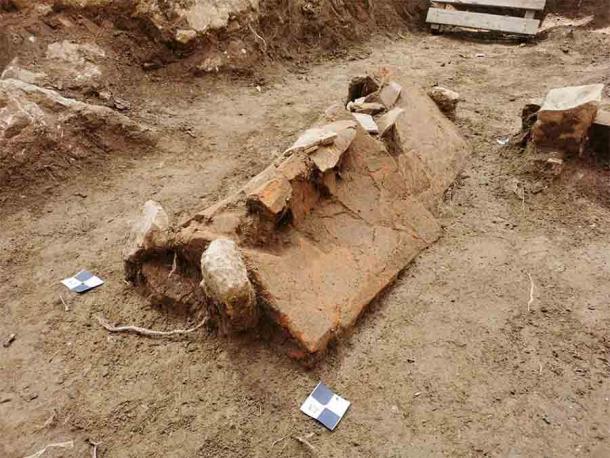
Ancient Necropolis Found Hidden in 17th Century Croatian Palace Garden
An ancient necropolis dating to the 4th and 5th centuries AD has been discovered at a 17th-century palace on the idyllic Croatian island of Hvar. This Hvar necropolis is being called “the most important ever” in the island’s thousands of years of inhabitation.
Located in the Adriatic Sea, Hvar is best known today as a summer holiday resort. However, it has been part of a long history having been continuously inhabited since early Neolithic times. In the 8th century BC Illyrians settled the island and in 385 BC Greek colonists founded Dimos (presently Hvar) and Pharos (Stari Grad). In 219 BC the island was taken over by Rome, while Slavs fleeing the mainland in the 7th century AD settled on the island.
- 6,200-Year-Old Croatian Massacre Solved With Genetic DNA Study
- Nomadic Avar Warrior Graves From Dark Ages Unearthed in Croatia
Today, sunburnt history lovers wander the port town of Hvar taking in its impressive 13th-century walls. The hilltop fortress overlooks a main square anchored by the Renaissance-era Hvar Cathedral. Earlier this month archaeological consulting company Kantharos announced the discovery of an ancient “necropolis containing 20 graves with the remains of 32 individuals and a wealth of goods, including intact amphorae, oil lamps, glass bottles, money, and examples of pottery and ceramics.” The haul at the Hvar necropolis is being called “the most important in the island’s history.”

Archaeologists came across this “important” Hvar necropolis discovery while excavating in preparation of a new island library. (Kantharos)
Could Hvar Necropolis Really be the Island’s Most Important Discovery?
Kantharos archaeologists have spent the past two months excavating the area in preparation for a new island library. During this work they found the ancient necropolis beneath the front garden Radošević Palace that was erected by the Radošević-Radossio family in the 17th-century. The area was later taken over by the family de Lupis and Doimi, and with its openings, low balconies, and the overhanging terrace, the north façade is representative of the famous Baroque style.
Archaeologists from Kantharos said in a Facebook post that the discovery of the necropolis is “the most important and richest site ever discovered in Hvar.” This is quite a claim considering the port was a hub of ancient Greeks and Romans, and it was also used as a Medieval Venetian shipping port as well as a naval base for the Venetian Empire until 1776 AD.

A wealth of grave goods was found at the Hvar necropolis including amphorae, oil lamps, glass bottles, money, pottery and ceramics. (Kantharos)
The team of archaeologists included Eduard Visković, Joško Barbarić, Marko Bibić, and Jure Tudor, who worked with Tina Neuhauser Vitaljic, Marine Ugarković, and Joseph Barack Perica, and it was this same group that discovered 5th century ramparts with a city gate, and a stone wall dating back to the 2nd century AD.

A range of different burial styles were also uncovered at the Hvar necropolis. (Kantharos)
Range of Burial Styles at Croatian Necropolis
The team of excavators found evidence of a range of different burial styles at the Hvar necropolis, from simple stone box graves to elaborately built structures with tiled roofs. A report in Smithsonian says that in one tomb the researchers discovered 12 skeletons. Furthermore, this particular burial vault was completely walled in with stonework which suggests its patrons were considerably wealthy, or resourceful.
What’s more, the remains and grave goods were interred and sealed inside large amphorae, evidence of adherence to burial rituals and rites that have until now been a tightly locked historical secret. The team researchers say much more analysis of the remains is required to provide details on the specific funerary customs from the 2nd to the 5th centuries AD and they plan to conduct radiocarbon dating on the various layers of remains found at the Croatianisland to add details to what is emerging to be a fascinating snapshot from the past.
- Remarkable ‘Sewn’ Roman Shipwreck is Croatia’s Biggest Find of 21st Century
- Lara Crufts Sniff Out Ancient Tombs In Croatia
Once this excavation is complete the archaeologists think they will have learned much more about two specific aspects of the island’s rich, but relatively unknown history. Firstly, the number of clay vessels found in the Hvarnecropolis will reveal “new insights into ceramic production.” Secondly, the wide range of ritualistic grave goods will allow the researchers to better illustrate their ever strengthening map of the Croatian island’s ancient trade connections with surrounding islands and distant shippers.
Top image: The archaeologists unearthed an individual buried in an amphora within the Hvar necropolis. Source: Kantharos
By Ashley Cowie















